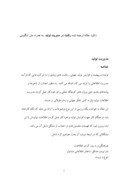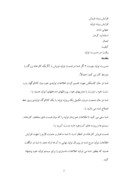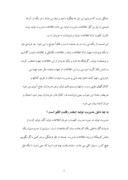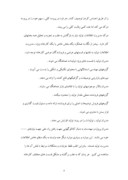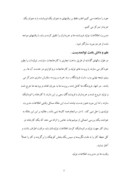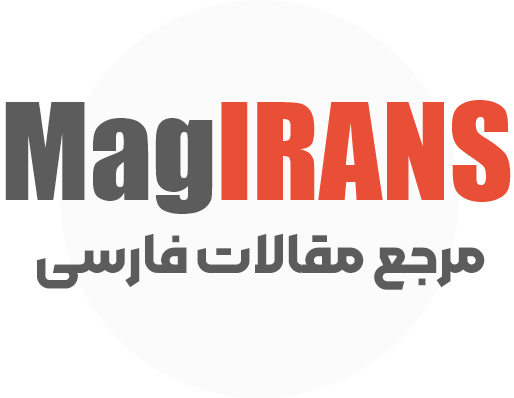بخشی از مقاله
دانلود مقاله ترجمه شده رقابت در مدیریت تولید به همراه متن انگلیسی
مدیریت تولید
خلاصه
تولیدات پیچیده و افزایش تولید جهانی , رقابت های زیادی را به شرکت هایی که فرآیند مدیریت اطلاعاتی را تولید می کند اضافه می کنند . به منظور اجتناب از تاخیرها و پیامدهای بعدی حتی پروژه های کوچک محلی برای خودکار عمل کردن مدیریت اطلاعات تولید نیاز به کمی تفکر جهانی و زمان طولانی تر هستند .
این مقاله به خواننده یک بررسی از این نوع موضوعات را ارائه می دهد که یک کارخانه باید در هنگام کار جهت افزایش تولید و خودکار عمل کردن اطلاعات تولیدش با این ایده روبرو شود که فهمیدن نخستین قدم در اجتناب از مشکل ناحل آن می باشد .
مشکلاتی که در اینجا درباره آن بحث خواهیم کرد شامل :
هماهنگی و به روز کردن اطلاعات
دارا بودن حداقل ساختار اطلاعاتی متداول
تنوع و تربیت
افزایش روند فروش
افزایش روند تولید
جهانی شدن
استاندارد کردن
اعمال
کیفیت
رقابت در مدیریت تولید
مقدمه
مدیریت تولید چیست ؟ اگر شما در قسمت تولید فروش یا IT یک کارخانه بزرگ یا متوسط کار می کنید احتمالاً :
شما در حال کشمکش جهت تقسیم کردن اطلاعات تولیدی خود میان کاتالوگها , وب سایت خود , اینترنت یا مشتریهای خود , پورتالهای (مدخلهای) تولید هستید یا :
شما در حال صحبت درباره تکمیل یک پروژه تولید یا یک کاتالوگ تولیدی روی خط اصلاح شده می باشید یا :
شما سعی می کنید تا اطلاعات هم زمان تولید را که میان قسمت های مختلف کارخانه , سیستم ها و پروسه های آن وجود دارد بدست آورید یا :
قسمت فروش کارخانه در انتظار است تا شما ساختار و حمایت لازم را جهت افزایش اطلاعات تولید درج شده در پورتال تولید نهایی به آن ها ارائه دهید یا شما در شگفت هستید که چطور شما می توانید اطلاعات مناسبتری را برای سیستم تولید خود پیشنهاد کنید .
مشکل نیست که دریابیم این نیاز ها چگونه با هم مرتبط می باشند , هر یک از آن ها قسمتی از نیاز بزرگتر اطلاعات مدیریت تولید می باشد اطلاعات مدیریت تولید روند کنترل کیفیت ارائه اطلاعات تولید از فروشنده به خریدار است .
این قسمت از یک تی رت در هر صنعت است و ظاهراً بغرنج تر می شود . هر فروشی نیاز به یک فروشنده جهت ارائه اطلاعات تولید , اطلاعات تکنیکی و اطلاعات قیمت گذاری و توصیفات تولید , گرافیک ها دارد و یک خریدار از این اطلاعات جهت انتخاب کردن و داشتن یک گزینه سود می برد این اطلاعات از جهات متعدد مثل جنبه مهندسی بازاریابی , تهیه کننده های چند تایی و مدیریت تولید و انتقال از طریق کانالها و کاتالوگهای چاپی , وب سایتها وسیستم های تولید برای خریداران جمع آوری می شود .
هرچقدر تعداد این جوانب یعنی فروشنده ها , کانال ها و خریداران بیشتر شود احتمال و میزان اشتباه بیشتر می شود .
به چه دلیل مدیریت تولید اینقدر رقابت انگیز است ؟
مدیریت تولید در مورد مدریت کیفیت و جریان اطلاعات تولید گذر تولید کرده از فروشندگان داخلی یک کارخانه و میان کارخانجات است . بسیاری از مدرم مسول یک بخش کوچک از روند اطلاعات مدیریت هستند از نظر فرهنگی مردم کمی , اگر نگوییم هیچ کس , مسول کلی می باشند . مشابه رقابت چند فرد نا بینا که سعی دارند تا یک فیل را از طریق احساس کردن توصیف کنند , هر فرد در پروسه کلی , سهم خود را در پروسه درک می کند اما عده کمی رقابت کلی را می بینند .
درک مدیریت اطلاعات تولید نیاز به بازگشتن به عقب و تجزیه و تحلیل همه بخشهای کار دارد . بیشتر از نگاه به عملکرد یک بخش خاص یا یک کارخانه ویژه , مدیریت اطلاعات تولید به نقشها و قسمتهای عرضی و فروشندگان عرضی کارخانه توجه دارد .
مدیران تولید با قسمت های ویژه تولیدات هماهنگ می شوند .
گروههای مهندسی استدلالهایی با محتوای تکنیکی و شکلی را بدست می آورند .
تیم های بازاریابی توصیفات و گرافیکهای قانع کننده را ارائه می دهند .
مدیران بالاتر موجودیهای تولید را با تقاضای بازار هماهنگ می سازند .
گروههای فروشنده محلی مقدار تولید را محدود میکنند .
گروههای فروش توضیحات اصلی را برای فروشنده ارائه داده و مسئول قیمت گذاری و قرار بستن با مشتری می شوند .
مدیران تولید , تولیدات را در روند تولید افزایش می دهند .
مدیران پروژه و مهندسان به دنبال کاتالوگهایی جهت یافتن راه حلی جهت نیازهای ---- خود می باشند . این موارد و بسیاری موارد دیگر همه وابسته به یک منظم خاص اطلاعات مدیریت تولید هستند . بنابراین اغلب فقط جزئیات و مشکلات مرتبط با نقش آن ها را مشاهده می کنیم . هر زمان که به عقب برگشته و مشکل قسمت های مختلف کارخانه خود را مشاهده می کنیم اغلب فقط بر رقابتهای به عنوان یک فروشنده یا به عنوان یک خریدار تمرکز می کنیم .
مدیریت اطالاعات تولید فروشنده ها و خریداران را تلفیق کرده و باید با رقابتهای مواجه شده از هر دو مورد سازگار شود .
علم و دانش باعث توانمندیست .
در طول سالهای گذشته از طریق ساخت تجاری یا کارخانجات سازنده , تولیدات را بطور خودکار می سازند یا پروسه های تولید و کارخانجات نرم افزاری در خدمت آن ها , بر روی نتیجه نهایی وب سایت فروشگاه , سبد خرید و پروسه سفارش مشتری متمرکز می باشند . در انتها , فروشگاه ها کامل شده , پروسه ها به جریان افتاده و بودجه ها خرج شده و تولید شروع شده و خریداران با فروشندگان سعی بر این دارند تا کارخانه را اتوماتیک سازند , اما این مورد هنوز بدست نیامده است این مقاله مسائل رقابتی اطلاعات مدیریت تولیدی را حل نمی کند . تا در سرانجام همه کارها نمی باشد , علاوه بر این این مقاله به خواننده یک بررسی اجمالی از موضوعات خاص را ارائه می دهد که یک کارخانه در زمان کار جهت تولید و اتوماتیک کردن اطلاعات تولیدشان باید مراقبت اطراف باشند و کل حیطه کار را به دقت نگریسته و سپس یک بخش کوچک را برگزیده و کار را عملاً آغاز نمایند .
رقابت ها در مدیریت اطلاعات تولید
بنابراین تجزیه و تحلیل فرآیند های اصلی بوسیله مدیریت اطلاعات تولید زمانی با محدودیت های روشهای متداول در میان بسیاری کارخانجات ترکیب می شود که مجموعه ای از رقابت های استاندارد معدنی شوند که باید با آن ها روبرو شده هر کارخانه از طریق اصلاح بازده مدیریت اطلاعات تولید کلی خود بر آن ها غلبه کند .
هماهنگی و به روز در آوردن اطلاعات : زمانیکه اطلاعات تولید اضافه شده یا بوسیله تولید کننده آن به روز در آورده می شود چطور این تغییر به همه کارخانجات که آن را مورد استفاده قرار می دهند می رسد ؟ چطور این تغییر می تواند با تعداد کمی از روشهای دستی , پروسه های گروهی , هماهنگی ها و اشتباهات اجرا شود ؟
موضوع سطح پایین ساختار اطلاعاتی متداول : اطلاعاتی که چاپ می شود یا میان سیستم ها هماهنگ می شود به طور ثابت محدود به زیر مجموعه اطلاعاتی است که در میان کل سیستم هایی که در آن مهم دارند , متداول است بنابراین , پروسه کلی نمی تواند یک قسمت جدید از اطلاعات را بدون افزودن آن تولید باید یا اطلاعات کانی برای تولید و پروسه پیچیده تر را ارائه دهد یا خود را فقط محدود به ساده ترین تولیدات و پروسه ها کنند .
تنوع و ترتیب : بیشتر تولیدات در جهان BCB نیاز به حداقل سطح شکل یا گزینش تعدادی از گونه ها دارد . حتی کمی از فروش تولید – یک فرد با چندین ویژگی و تعدادی از ارزشهای قابل گزینش برای هر ویژگی می تواند در میلیونها گونه تولید به وجود آید . پروسه مدیریت اطلاعات تولید باید روشی برای اداره گونه های تولید و برای گزینش از میان انواع مختلف را دارا باشد .
افزایش پروسه فروش : مدیریت اطلاعات تولید به تنهایی به عنوان یک قانون عمل نمی کند بلکه بیشتر باید با مدیریت ارتباط بین فروشنده , مشتری و بازار را افزایش دهد . موارد افزایش تولید شامل پروسه های بازاریابی , کاتالوگهای چپ شده , ابزار اطلاعات نیروی فروش داخلی و سیستم های CRM یا ERP می باشد .
افزایش پروسه تولید : پروسه مدیریت اطلاعات تولید فثط زمانی کامل است که مشتری اطلاعات مورد نیاز جهت تصمیم گیری درمورد خرید را داشته باشد . زیرا اغلب سازمان های بزرگ تکمیل کننده سیستم های تولیدی برای اداره پروسه های خرید خود هستند , مدیریت اطلاعات تولید باید با سیستم ها بطور کاملی تلفیق شود .
جهانی شدن : برای همه به جز ساده ترین و محدود ترین تجارت , مدیریت اطلاعات تولید باید لایه های افزایش یافته پیچیدگی به وجود آمده بوسیله سازمان های فروش محلی , گروه های چند زبانه دارای و چند ویژگی و موجودیتهای تولید و محلی و سیستم های قیمت گذاری و ارزها و نوسانات و بازار محلی و نیازهای تجاری را مخاطب قرار دهد .
استاندارد کردن : باید استانداردهای داخلی مدیریت اطلاعات تولید در کارخانه توسعه یافته و از استاندارد های خارجی برای طبقه بندی تولید جهت تشخیص ویژگیهای تکنیکی پیروی شود . روند پروسه باید در یک سازمان استاندارد شده و با سیستم های خارجی دارای اشتراک باشد .
عملکرد ها : مانند هر قانون دیگری در یک سازمان اگر مدیریت اطلاعات تولید بطور موثری اجرا شود , نیاز به پروسه های دیگری دارد که جهت اطمینان یافتن از اجرای دقیق روند مدیریت اطلاعات تولید وجود داشته باشند تا مردم به طور صحیح مورد آموزش قرار گرفته و شیوه ها را دنبال کنند و نکاتی در مورد افزایش تولید آزمایش و حفظ شود .
کیفیت : Garbage In و - Garbage outبرای پذیرفته شدن و تاثیر گذاشتن پروسه های مدیریت اطلاعت تولید یک کارخانه باید بطورتان پیش کیفیتی بسیاری را ارائه دهد . این کار نیاز به آزمایش و اطمینان از کیفیت در مورد هم اطلاعات و هم شیوه های به کار برده برای دستیابی به آن را دارد .
Challenges in Product Management
Product management
Summary
Complex products and global integrations add additional challenges to a companies product information management process. In order to avoid delays and future issues, even small local projects to automate product information management need to think a bit globally and longer term.
This white paper provides the reader with an overview of the typical issues a company has to face when working to integrate and automate its product information, with the idea that understanding the problem is the first step in avoiding or solving it.
The problems discussed include:
• Data Synchronization and Update
• The “Minimum Common Data Structure” Issue
• Variation and Configuration
• Sales Process Integration
• Procurement Process Integration
• Globalization
• Standardization
• Operations
• Quality
Challenges in Product Management
Introduction
What Is Product Management?
If you work in procurement, sales or IT for a large or mid-sized company, it’s likely that:
• You’re struggling to coordinate your product information between catalogs, your web site, your intranet or your customers’ e-procurement portals, or
• You’re talking about implementing a product configurator or an improved online product catalog, or
• You’re trying to maintain and synchronize product data internally between multiple divisions, systems, and processes, or
• Sales is looking to you to provide the infrastructure and support to integrate product information into a customer’s e-procurement portal, or
• You’re wondering how you can streamline your procurement process, or how to get vendors to provide better information for your e-procurement system.
It’s not hard to see how these questions are related; each is a piece of the larger question of product information management.
Product information management is the process of controlling the quality and flow of product information from seller to buyer.
It’s a part of every business in every industry, and it’s become exponentially more complicated. Every sale requires a seller to provide product information - technical information, pricing information, product descriptions, graphics - and a buyer to use this information to make a choice. This information comes from multiple sources – engineering, marketing, sub-suppliers and product management and moves through multiple “channels” - print catalogs, web sites, procurement systems - to multiple buyers. As the number of each increases - sellers, channels, buyers - so do errors and costs.
Why Is Product Management So Challenging?
Product management is about managing the quality and flow of product information across internal boarders within a company and between companies. Many people are responsible for a small portion of the overall product information management process, but traditionally few people, if anyone, are responsible for the entirety. Similar to the challenge of multiple blind men trying to describe an elephant by feel, each participant in the overall process understands his part in the process, but few see the complete challenge.
Understanding product information management requires stepping back and analyzing the whole process, from all points of view. Rather than looking at the work of a single department, or a single company, product information management looks across roles, across departments, and across company boundaries.
• Product managers coordinate specific ranges of products.
• Engineering teams maintain technical content and configuration logic.
• Marketing teams develop convincing descriptions and graphics.
• Portfolio managers build product portfolios appropriate to the market.
• Regional sales teams localize and translate content.
• Sales teams maintain a customer centric view, being responsible for a customer’s pricing and contracts.
• Procurement managers integrate suppliers into their procurement process.
• Project managers and engineers search catalogs to find the solution to their current needs.
These, and many others, are all connected to of the same discipline - product information management. Most, however, see only the details and problems associated with their own role. Even when taking a step back and analyzing the problem across the divisions within their own company, most focus only on their own challenges as a seller or as a buyer.
Product information management integrates sellers and buyers and must adapt to the challenges faced by both.
Knowledge is Power
During the past years, through the e-business build out, both companies building automated sales or e-procurement processes and the software companies serving them focused on the end result – the website, the store, the “shopping basket” and the ordering process. In the end, the stores were completed, the processes rolled out, the budgets gone, and the product content – that which the buyers or sellers were trying to automate, was still missing.
This white paper does not solve the challenges surrounding product information management. There is no silver bullet, and no one system that does it all. Rather, This paper provides the reader with an overview of the typical issues a company has to face when working to integrate and automate its product information, with the idea that understanding the problem is the first step in avoiding or solving it.
This paper is also not meant to intimidate, showing a nightmare scenario in order to scare the readers into an overblown project or solution. Companies organizing their product information management processes should look around, see the full scope of the issue, and then pick a small area and just pragmatically begin.
Challenges in Product Information Management
An analysis of the core processes within product information management, however, when combined with the limitations of the current methods running within many companies, reveals a series of standard challenges that must be faced and overcome by any company wishing to improve its overall product information management efficiency.
• Data Synchronization and Update:
When product information is added or updated by the supplier at its source, how does this change reach all of the places where it is used? How can this be accomplished with a minimal number of manual processes, batch processes, synchronizations, and errors?
• The “Minimum Common Data Structure” Issue: Information that is copied or synchronized between systems is inherently limited to the subset of information that is common among all systems sharing it. Hence, the overall process cannot add a new piece of information without adding it to all affected systems and interfaces. The product information management process must either manage enough information for the most complex product and process, or limit itself to only the simplest products and processes.
• Variation and Configuration: Most products in the B2B world require at least some level of configuration or selection from a number of variants. Even a low level of product customization - one with several attributes and a number of selectable values for each attribute, can result in millions of variants for the product. The product information management process must have a method for managing product variations and for selecting from among the variants.
• Sales Process Integration: Product information management does not stand alone as a discipline; rather it must integrate with Sales, Customer Relationship Management and Marketing. Typical integration points include marketing processes, printed catalogs, internal sales force information tools and CRM or ERP systems.
• Procurement Process Integration: The product information management process is complete only when the customer has the information he needs to make a purchasing decision. Since most large organizations are implementing e-procurement systems to manage their own buying processes, product information management must be integrated seamlessly with these systems.
• Globalization: For all but the simplest and most local businesses, product information management must address the increased layers of complexity created by regionalized sales organizations, multiple languages and character sets, regional product portfolios and pricing systems, multiple currencies and fluctuations, and local marketing and branding requirements.
• Standardization: must develop internal standards for product information management within the company and adhere to external standards for product classification and for specification of technical attributes. Process flow has to be standardized within an organization and interfaced with external systems.
• Operations:Like any discipline within an organization, if product information management is going to run effectively, it requires additional processes be in place to ensure that the product information management processes are running correctly, that people are correctly trained and procedures are followed, and that integration points are tested and maintained.
• Quality: Garbage In - Garbage Out. To be accepted and effective, a company’s product information management processes must provide predictably high quality information. This requires regular testing and quality assurance on both the data and the processes used to maintain it.
http://www.findarticles.com/p/search?qt=Product+Management+&qf=free&tb=art&x

